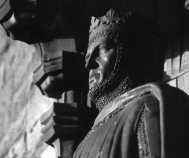Robert the Bruce

He was the hammer of the English - the legendary Scot who commanded the Flowers of Scotland and sent proud Edward home to think again.
Robert I, King of Scots, was the architect of our country's greatest ever victory over the English at Bannockburn, driving them out and uniting all Scotland in a burning desire for independence.
Bruce took up the reins of Scotland's freedom as the other great patriot of the age, Sir William Wallace, was forced to let them go. Robert was crowned king in a year after Wallace was hung, drawn and quartered by the English in 1305, and he became determined to achieve the one feat his heroic predecessor had never managed - to free Scotland of the marauding English.
Robert the Bruce - the name comes from the Norman surname De Brus - was the eldest son of one of the richest and most famous Scottish nobles, also called Robert, who had royal Scottish blood in his veins. Robert was born in Essex or in Turnberry, Ayrshire, on July 11, 1274. The young man was well educated and was also trained in the arts of warfare. His chance to seize the throne came after John Balliol abdicated in 1296, following a raid on Scotland by Edward I. Edward imprisoned Balliol and decided to rule the Scots himself. Robert knew he would have to defeat the forces of powerful Scots families such as the Comyns and McDougalls who supported the Balliol line. Peace was kept when Robert and John "The Red" Comyn were appointed joint guardians of Scotland after Wallace resigned the position in 1298. Two years later, Bruce gave up the title and, despite his driving desire to free Scotland, decided to submit to Edward. Why he did is a mystery. It could be Robert wanted to protect his land, titles and influence and felt this was the best way of going about it.
In 1304, Bruce began to secretly work with Scottish rebels, but John Comyn tipped off Edward about the Bruce's divided loyalties and Robert was lucky to flee to London with his life. Furious at this treachery, Robert vowed vengeance. He asked Comyn to meet him at Greyfriars Church, in Dumfries, on February 10, 1306. There was a struggle and Comyn ended up dead - either slain by Bruce on the altar, or killed by one of Bruce's knights. The way was open for Robert to take the Scottish throne. He was crowned at Scone the following month and many of the nobles rallied to him.
After defeats by the English at Methven near Perth in June, then by Comyn's close colleague, the Lord of Argyll, at Dalry in August, Robert was forced into hiding. He fled to Rathlin Island off the coast of Ulster and stayed there until February 1307.
Bruce defeated an English force at Loudoun in 1307 and also won a battle against John Comyn, Earl of Buchan and cousin of the slain John. The Bruce's supporters captured Galloway, the forest of Selkirk and the eastern Borders and, between 1310 and 1314, he won control of northern Scotland. In 1307, Edward I had finally died, leaving the throne for his son Edward II, who was not nearly so enthusiastic about crushing the Scots.
By 1314, Robert had captured control of all of Scotland's main castles except Berwick - not yet an English town, as it is today - Bothwell and Stirling. But Edward II was finally stirring. When the Bruce and his forces laid siege to Stirling Castle, a massive English army was sent north to relieve it. Both sides knew the clash was about far more than the capture of the castle. For Edward, it was a last ditch attempt to seize control of Scotland and subjugate its troublesome people once and for all. For the Bruce, it represented the opportunity to give the English a hiding they would never forget.
Edward came north with the cream of his cavalry and infantry in a force of up to 30,000 men and the two sides squared up to each other on June 24, 1314. Bruce, who had only between 5000 and 10,000 men, positioned his soldiers in a spot south of the town where he knew trees would hamper an attack by the well trained English horsemen. A genius at guerrilla warfare, the Bruce knew how to make best use of the terrain.
The English were confined in a small and marshy area between the River Forth and the Bannock Burn. Robert took advantage of the confusion and launched an attack. The Scots forced the English back into the burn. A charge of about 2000 Scots came down from the nearby hills and sent Edward's army reeling. Those English who were not put to the sword perished in the Bannock Burn or died in their attempts to escape. The dejected English king fled, finally finding safety at Dunbar, where a ship took him back to England.
Bannockburn was Scotland's greatest ever military victory against the English. Edward's army was completely smashed and he had to abandon hopes of conquering Scotland. But the battle was even more important in neutralising the threat against Robert from the Scottish nobles who still despised him.
King Robert could finally devote his energies to the affairs of his kingdom. All though, was not well. One powerful figure refused to recognise Scotland's nationhood - the Pope.
Robert and his nobles saw that they had another crucially important battle to fight - this time not with the sword, but with the pen.

Highlands of Scotland Menu...
Please sign our Guestbook